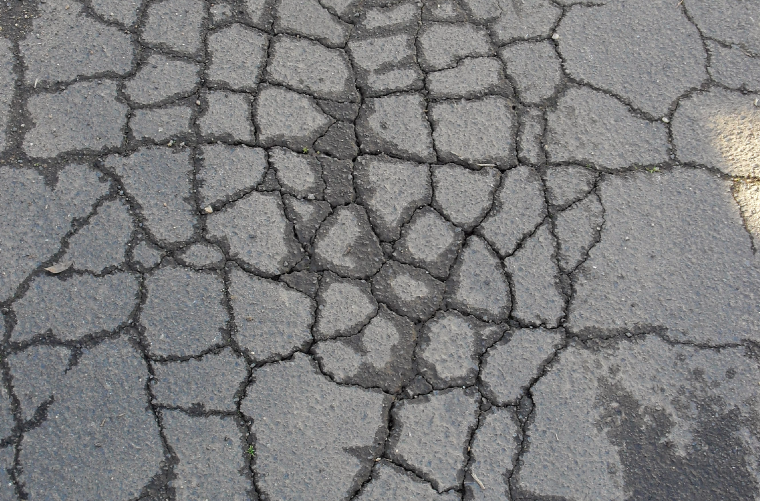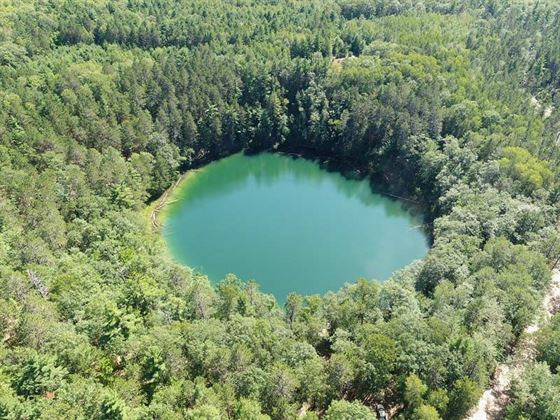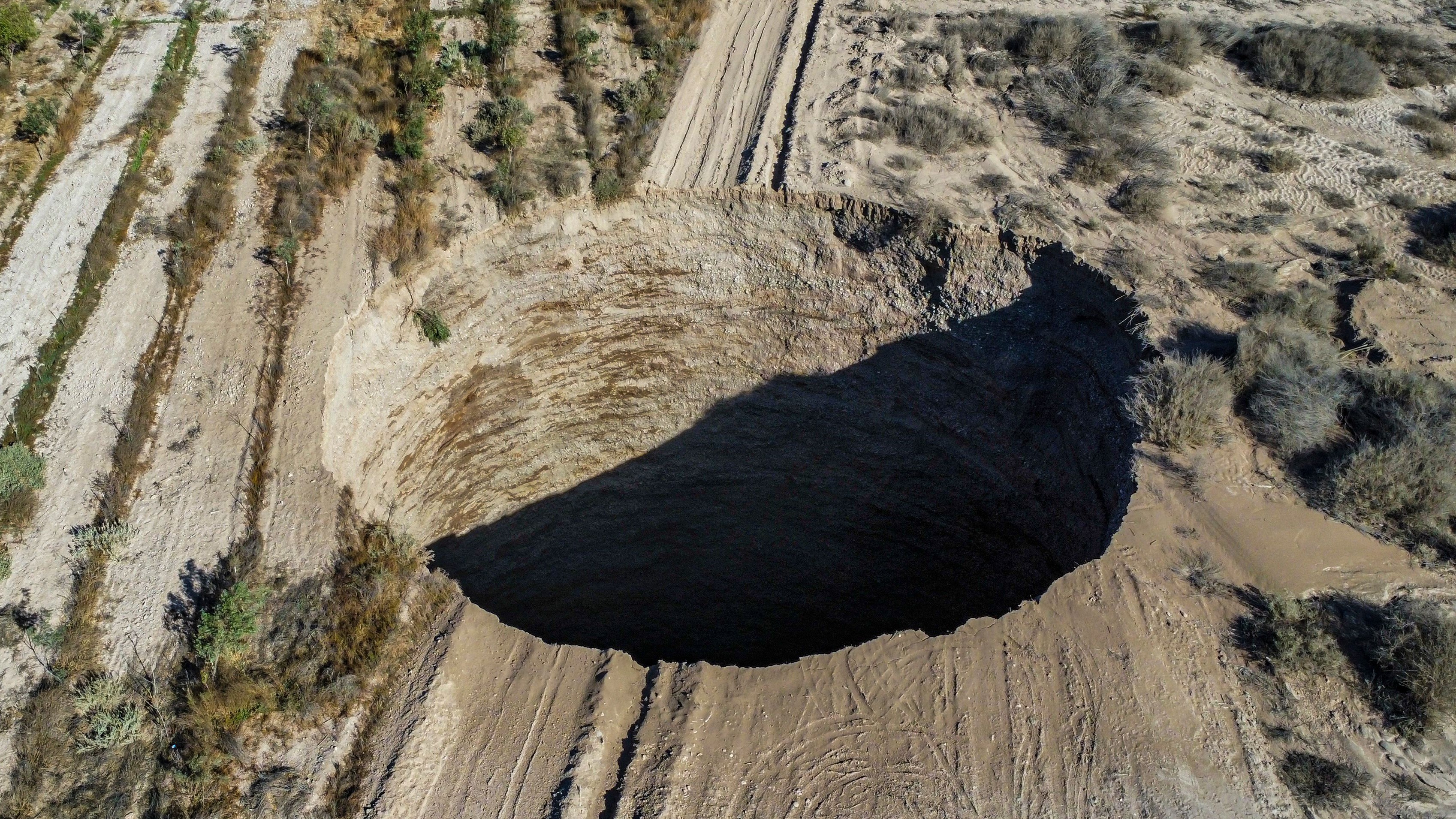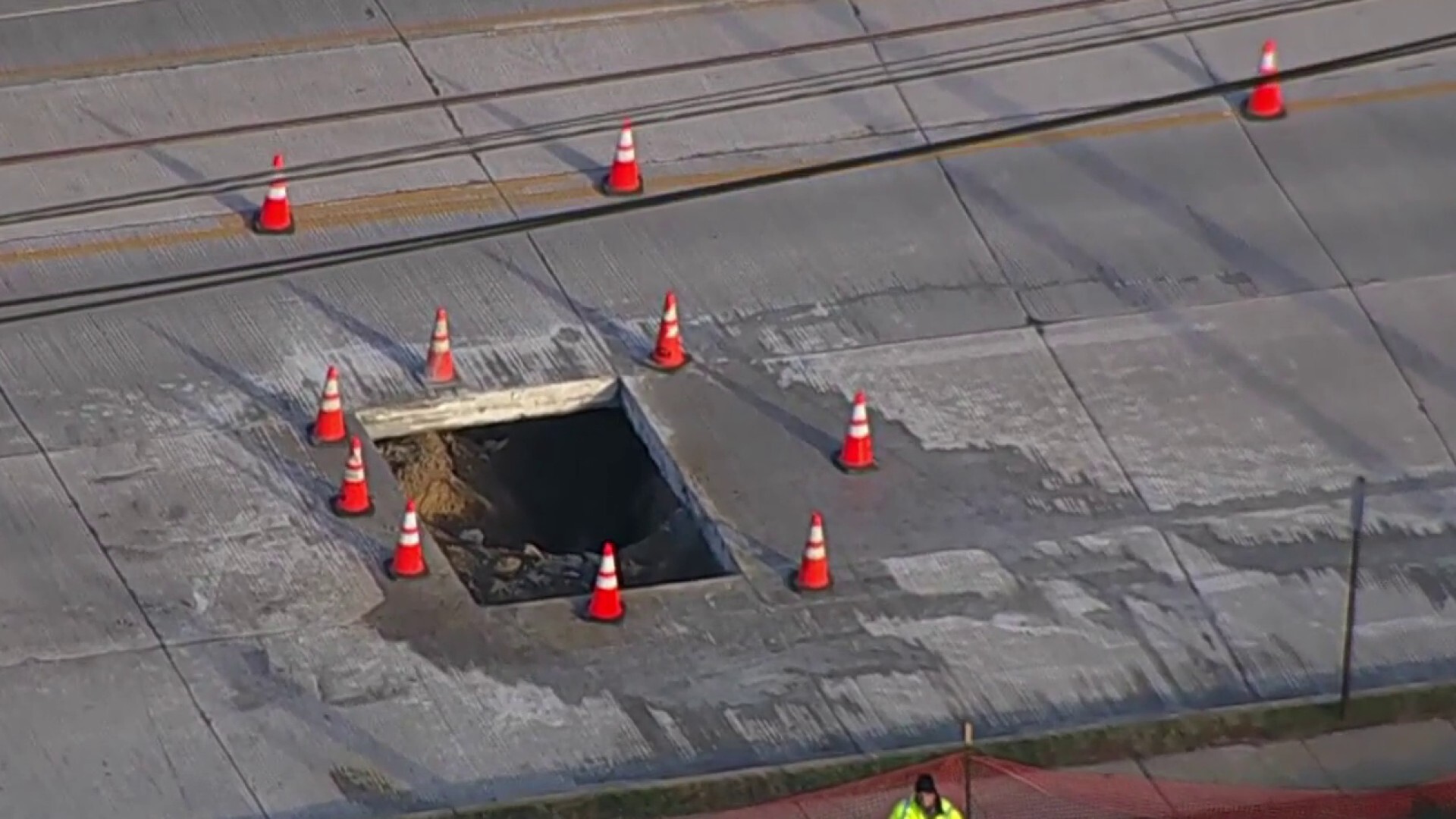Topic how does a sinkhole form: Discover the fascinating process behind sinkhole formation, a natural phenomenon that shapes our landscape and influences our environment in profound ways.
Table of Content
- How does a sinkhole form?
- What is a Sinkhole?
- Introduction to Sinkholes
- What Causes Sinkholes to Form?
- Types of Sinkholes
- YOUTUBE: Understanding the Formation of Sinkholes
- The Process of Sinkhole Formation
- Human Activities and Their Impact on Sinkhole Formation
- Regions Most Affected by Sinkholes
- Signs That a Sinkhole Is Forming
- Preventing and Mitigating Sinkhole Damage
- Case Studies of Major Sinkhole Events
How does a sinkhole form?
There are several factors that can contribute to the formation of a sinkhole:
- Overwithdrawal of groundwater: When groundwater is excessively pumped out, it can create empty spaces underground, leading to the collapse of the surface.
- Diverting surface water: Re-routing of surface water, such as through drainage systems or construction projects, can cause erosion and gradual weakening of the ground above.
- Disturbance of the soil: Activities like mining, construction, or drilling can disrupt the stability of the ground, making it more prone to collapse.
- Natural geological processes: Certain types of rock, like limestone or gypsum, are more susceptible to dissolution by water, forming underground cavities that can eventually cause sinkholes to form on the surface.
READ MORE:
What is a Sinkhole?
A sinkhole is a depression or hole in the ground caused by the collapse of a surface layer. It can vary in size from a few feet across to several hundred acres and can be as shallow as less than 1 foot to more than 100 feet deep.
How Do Sinkholes Form?
Sinkholes typically form in regions known as karst terrain, where the type of rock below the land surface can be naturally dissolved by groundwater. The process of sinkhole formation involves the dissolution of carbonate rocks such as limestone, dolomite, and gypsum by slightly acidic water. This water can come from rainfall percolating through the soil, which absorbs carbon dioxide and reacts with decaying vegetation.
Types of Sinkholes
- Solution Sinkholes: Form in areas where there is little to no cover over soluble rocks. Rainwater directly dissolves the rock surface, leading to a depression.
- Cover-Subsidence Sinkholes: Occur where sand covers the bedrock. The sand gradually moves into openings in the rock, creating a sinkhole at the surface.
- Cover-Collapse Sinkholes: The most dramatic and dangerous type. They form where an underground cavity becomes too large to support its ceiling, causing a sudden collapse of the overlying ground.
Factors Influencing Sinkhole Formation
- Acidic Rainwater: Natural acid in rainwater can dissolve underground rocks.
- Human Activity: Such as water pumping, construction, and mining activities can trigger sinkhole formation.
- Natural Erosion: Processes can lead to the enlargement of natural voids under the ground.
Preventing and Mitigating Sinkhole Damage
While entirely preventing sinkhole formation is challenging, understanding the underlying causes can help mitigate risks. Regular geological surveys and monitoring water management practices can reduce the likelihood of sudden collapses, especially in areas prone to sinkholes.
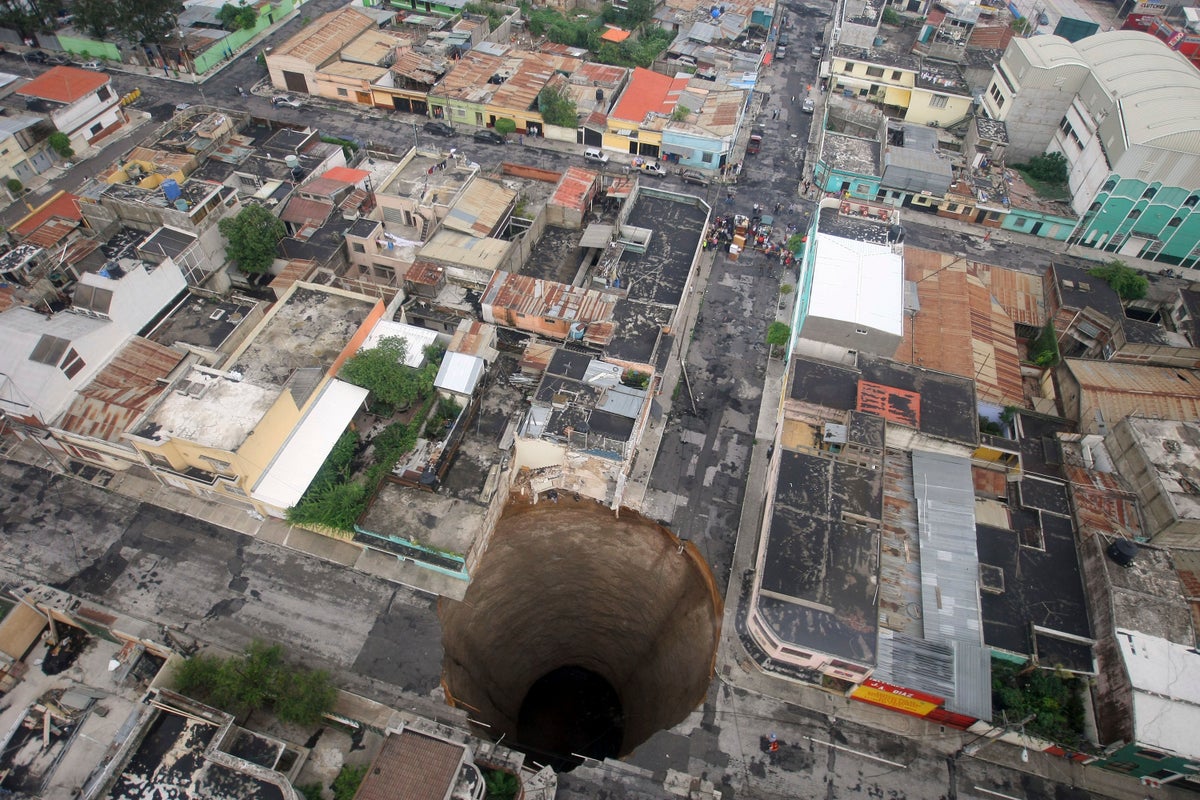
Introduction to Sinkholes
Sinkholes are fascinating geological phenomena that occur across the globe, forming depressions or holes in the Earth"s surface. They can vary greatly in size, from a few feet to hundreds of acres, and in depth, from less than one to more than one hundred feet deep. Some sinkholes are shaped like shallow bowls or saucers, while others have vertical walls. Certain sinkholes may hold water and form natural ponds, contributing to diverse ecosystems.
The creation of sinkholes typically involves natural processes, such as the dissolution of carbonate rocks (limestone, dolomite, gypsum) by slightly acidic water. This water, often rainwater that has absorbed carbon dioxide from the atmosphere and soil, percolates through the soil, dissolving the rock underneath over time. The process can be slow and gradual, leading to little noticeable change, or it can occur suddenly, causing a dramatic collapse of the surface layer.
Sinkholes are most common in areas known as karst terrains, characterized by their soluble bedrock that can be easily dissolved by groundwater. These phenomena not only create unique landscapes but also pose significant challenges in terms of water management, construction, and urban planning in affected regions.
- Types of Sinkholes: Solution sinkholes, cover-subsidence sinkholes, and cover-collapse sinkholes.
- Causes: Natural erosion by acidic rainwater, human activities such as construction and mining, and the dissolution of rock below the ground.
- Prevention and Mitigation: Includes conducting regular geological surveys and careful water management practices.
Understanding the formation and characteristics of sinkholes is crucial for mitigating risks and managing the impacts on human activities and the environment. This introductory section aims to shed light on these intriguing natural features, exploring their causes, types, and the processes involved in their formation.
What Causes Sinkholes to Form?
Sinkholes are a natural occurrence resulting from a combination of geological processes and environmental conditions. They form primarily due to the dissolution of soluble bedrock by acidic water, a process that creates underground cavities and voids. Over time, these cavities can grow large enough that the ground above collapses, creating a sinkhole.
- Acidic Rainwater: Rainwater absorbs carbon dioxide from the atmosphere and the soil, becoming slightly acidic. This acidic water can dissolve carbonate rocks such as limestone, dolomite, and gypsum, which are common in karst terrains.
- Underground Water Flow: Water flow beneath the ground can erode bedrock, enlarging existing cavities and creating new ones. This erosion can eventually lead to the collapse of the surface layer.
- Human Activities: Activities such as drilling, mining, construction, and excessive groundwater withdrawal can also contribute to sinkhole formation by altering natural water drainage patterns or by creating new pathways for water to erode the bedrock.
- Natural Erosion: Over time, natural erosion processes can lead to the expansion of underground cavities and the eventual collapse of the ground above, forming a sinkhole.
While most sinkholes form slowly, allowing for some prediction and mitigation, some can collapse suddenly, posing significant risks to buildings, roads, and other infrastructure. Understanding these causes is crucial for risk assessment and for the development of strategies to prevent or mitigate damage in sinkhole-prone areas.
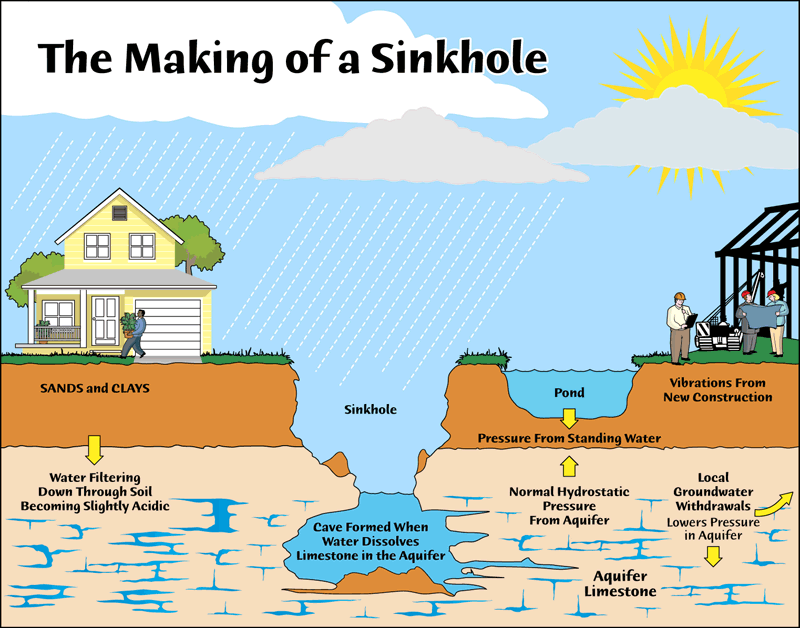
Types of Sinkholes
Sinkholes are categorized into three main types based on their formation processes and characteristics. Understanding these types helps in identifying and managing them effectively.
- Solution Sinkholes: These sinkholes form directly in soluble rock with a water table below the surface. They occur when acidic rainwater dissolves the rock surface, gradually creating a depression. Solution sinkholes are common in areas with visible bedrock.
- Cover-Subsidence Sinkholes: Forming in areas where sand and sediments cover the bedrock, these sinkholes develop slowly. As the underlying rock dissolves, the sand fills the voids, creating a gradual depression on the surface. They are less noticeable but can spread over a large area.
- Cover-Collapse Sinkholes: The most dramatic and potentially dangerous type, cover-collapse sinkholes happen when the support for the ground’s surface layer is removed. This type often occurs suddenly, leading to significant property damage and posing a risk to safety. They typically form in areas where the layer of sediment above the bedrock is cohesive, like clay, and a void underneath the surface layer enlarges until it no longer can support the weight above, leading to a sudden collapse.
Each type of sinkhole has unique indicators and poses different levels of risk. By understanding the types of sinkholes, communities and individuals can better prepare for and mitigate their impacts.
Understanding the Formation of Sinkholes
Embark on a journey through the captivating realm of geology as you discover the intricate processes that shape the Earth\'s surface. Gain a new appreciation for the beauty and complexity of our planet in this visually stunning video presentation.
Understanding the Formation of Sinkholes
Embark on a journey through the captivating realm of geology as you discover the intricate processes that shape the Earth\'s surface. Gain a new appreciation for the beauty and complexity of our planet in this visually stunning video presentation.
The Process of Sinkhole Formation
The formation of sinkholes is a complex process that involves several stages, primarily influenced by the type of rock beneath the surface and the presence of water. Here"s a step-by-step overview:
- Acidic Water Formation: Rainwater absorbs carbon dioxide from the air and organic acid from the soil, becoming slightly acidic.
- Dissolution of Bedrock: This acidic water percolates through the ground, gradually dissolving soluble rocks such as limestone, dolomite, or gypsum, which are common in karst landscapes.
- Cavity Creation: Over time, the continuous dissolution of rock creates voids or cavities underground. The size of these cavities can range from small spaces to large caverns.
- Subsurface Structure Weakening: As cavities grow, the structural integrity of the subsurface layers becomes compromised. However, the surface may remain intact, hiding the void below.
- Collapse: Eventually, the weight of the overlaying material may become too great for the weakened structure to support, leading to a sudden collapse of the surface into the cavity below, forming a sinkhole.
This process can be accelerated by human activities such as drilling, mining, construction, and excessive water withdrawal, which can change the natural water drainage patterns or increase the rate of dissolution of the underlying rock.
While the formation of sinkholes can sometimes be predicted and monitored, sudden collapses can occur, posing risks to infrastructure and safety. Understanding the process of sinkhole formation is crucial for effective land management and risk mitigation in susceptible areas.

Human Activities and Their Impact on Sinkhole Formation
While natural processes are primarily responsible for sinkhole formation, human activities have significantly contributed to their occurrence and severity. Understanding the interplay between human actions and geological processes is crucial for mitigating risks associated with sinkholes.
- Groundwater Withdrawal: The extraction of groundwater for irrigation, drinking water, and industrial use can lower the water table, destabilizing the support of underground cavities and leading to sinkhole collapse.
- Construction and Development: Heavy construction, including the building of roads, buildings, and other structures, can alter natural water drainage patterns and exert additional pressure on the land surface, increasing the likelihood of sinkholes.
- Mining Activities: Mining for minerals and other underground resources can create voids or weaken the structure of the rock below the surface, contributing to the formation of sinkholes.
- Water Leakage from Infrastructure: Leakage from sewer lines, water pipes, and irrigation systems can lead to the erosion of subsurface layers, exacerbating the conditions that lead to sinkhole formation.
- Land Use Practices: Agricultural practices, deforestation, and land clearing can remove vegetation that stabilizes the soil, increasing erosion and the potential for sinkholes.
Preventive measures, including careful planning and monitoring of water use and construction activities, can help minimize the impact of human activities on sinkhole formation. By recognizing and addressing these factors, communities can better protect themselves and their infrastructure from sinkhole-related damage.
Regions Most Affected by Sinkholes
While natural processes are primarily responsible for sinkhole formation, human activities have significantly contributed to their occurrence and severity. Understanding the interplay between human actions and geological processes is crucial for mitigating risks associated with sinkholes.
- Groundwater Withdrawal: The extraction of groundwater for irrigation, drinking water, and industrial use can lower the water table, destabilizing the support of underground cavities and leading to sinkhole collapse.
- Construction and Development: Heavy construction, including the building of roads, buildings, and other structures, can alter natural water drainage patterns and exert additional pressure on the land surface, increasing the likelihood of sinkholes.
- Mining Activities: Mining for minerals and other underground resources can create voids or weaken the structure of the rock below the surface, contributing to the formation of sinkholes.
- Water Leakage from Infrastructure: Leakage from sewer lines, water pipes, and irrigation systems can lead to the erosion of subsurface layers, exacerbating the conditions that lead to sinkhole formation.
- Land Use Practices: Agricultural practices, deforestation, and land clearing can remove vegetation that stabilizes the soil, increasing erosion and the potential for sinkholes.
Preventive measures, including careful planning and monitoring of water use and construction activities, can help minimize the impact of human activities on sinkhole formation. By recognizing and addressing these factors, communities can better protect themselves and their infrastructure from sinkhole-related damage.
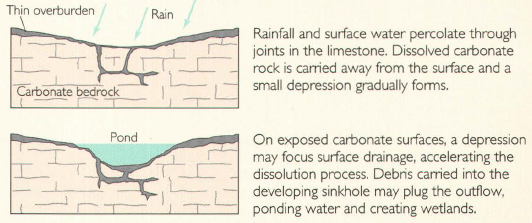
Signs That a Sinkhole Is Forming
Sinkholes are a natural phenomenon that can cause significant damage to the environment and structures. Identifying the early warning signs of a sinkhole can help mitigate risks and prevent accidents. Here are the most common indicators:
- Visible Depressions: Circular depressions in the earth are a telltale sign. These depressions usually have a round shape and indicate weakening ground support.
- Localized Subsidence: An area that has dropped down relative to the surrounding land could signify the development of a sinkhole.
- Water Accumulation: The appearance of circular lakes or large, deep puddles can indicate a sinkhole filled with water.
- Foundation Settling: If part of a structure starts dropping and cracking, it could be over a forming sinkhole. Monitoring foundation levels and employing geophysical tests can provide clarity.
- Cracks in Roads or Pavement: Crocodile or alligator cracks in asphalt suggest subgrade issues, possibly due to an underlying sinkhole.
- Well Water Levels Drop: A sudden decrease in well water levels can indicate a sinkhole"s impact on the water table.
- Rainwater Disappearing: If rainwater seems to vanish into ground openings, it might be entering an underground void, signaling sinkhole activity.
Beyond these physical signs, utilizing public resources like soil maps, karst area data, and subsidence reports can offer additional insights into potential sinkhole risks, especially in prone regions such as Florida, Alabama, Missouri, Kentucky, Tennessee, Pennsylvania, and Texas.
Preventing and Mitigating Sinkhole Damage
Preventing and mitigating sinkhole damage involves a combination of professional assessments, pre-construction measures, and regular property maintenance, especially in regions prone to sinkholes. Here are key strategies to minimize the risk:
- Professional Assessments: Before construction, consult with geologists or engineering firms to conduct soil testing and assessments for sinkhole risks. This can help identify potential issues before they become problematic.
- Pre-Construction Remediation: Implementing pre-construction remediation techniques, such as underpinning or stabilizing weak soils, can protect buildings from future structural damage caused by sinkholes.
- Pipeline Maintenance: Regularly inspect and maintain pipelines and infrastructure around your property. Replacing old or damaged pipelines can prevent water losses and reduce the risk of sinkhole formation due to water erosion.
- Installing Support Structures: In areas known for sinkhole activity, installing supporting piers or strong foundations can offer additional stability to structures and reduce damage risks.
- Local Authority Consultations: Work with local authorities to inspect and maintain public infrastructure, such as sewers and water lines, to prevent sinkhole development.
- Monitoring Warning Signs: Be vigilant for signs of potential sinkhole activity, such as cracks in the ground, buildings, roads, and sidewalks, or sudden changes in water pressure or quality. Early detection is key to preventing major damage.
Adopting these preventive measures can significantly reduce the risk of sinkhole damage. However, always consult with professionals for tailored advice and solutions specific to your property and region.

READ MORE:
Case Studies of Major Sinkhole Events
Sinkholes are dramatic natural occurrences that can have significant impacts on communities and landscapes. This section delves into notable case studies of major sinkhole events, highlighting the diverse causes and consequences of these geological phenomena.
Technological Advances in Sinkhole Detection and Monitoring
Recent advancements in technology have significantly improved our ability to detect and monitor sinkholes before they cause major damage. Satellite interferometry and airborne LiDAR are among the cutting-edge technologies being employed to spot early signs of sinkholes. These tools have been instrumental in identifying ground subsidence and potential sinkhole formation in areas prone to such events, such as the Dead Sea in Israel and the Ebro Valley in Spain. Satellite data has enabled the detection of precursory deformations, anticipating the occurrence of sinkholes and allowing for timely interventions.
Impact on Communities and Infrastructure
Sinkholes can cause extensive damage to infrastructure, including roads, buildings, and utilities, leading to economic losses and posing risks to human safety. For example, the use of GBInSAR technology allowed for the early detection of a sinkhole forming beneath a street, enabling local authorities to close the road and prevent potential accidents. This example underscores the importance of monitoring and early warning systems in mitigating the impact of sinkholes on communities.
Geological and Human Factors
Both natural processes and human activities contribute to the formation of sinkholes. Natural dissolution of carbonate rocks such as limestone, as well as human-induced factors like over-pumping of groundwater and construction activities, can lead to the development of these geological hazards. Regions with a high density of sinkholes often undergo extensive monitoring to manage and reduce the risk associated with sinkhole formation.
Case Study: The Role of Geological Maps in Sinkhole Management
Geological mapping has proven to be a valuable tool in identifying areas susceptible to sinkhole formation. By delineating karst features and understanding the underlying geology, policymakers and the public can develop strategies to minimize property damage and personal injuries caused by sinkholes. This proactive approach emphasizes the importance of geological knowledge in land-use planning and risk management.
Understanding the mechanisms behind sinkhole formation and leveraging technological advancements for early detection are key to reducing their impact. Through detailed case studies and the application of innovative monitoring techniques, we can better prepare for and respond to these unpredictable natural events.
